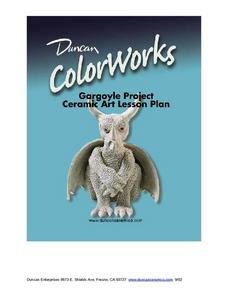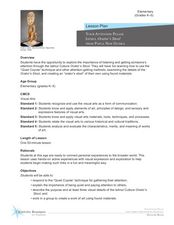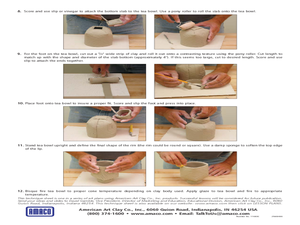Curated OER
Gargoyles: Ceramics
Study the symbolism and significance of Gargoyles throughout the Gothic era, and then make one. Kids visit three different websites to learn about these goolish protectors, then hone their sculpting skills while making one. They make...
Curated OER
Prepositions
Young readers practice using new vocabulary. They create clay animations that show examples of prepositions. They also create animated movies that help others learn the purpose of prepositions as well.
Curated OER
Owl Eyes.
Students create an animal with clay and use toothpick to draw or carve features. Students write descriptions of their animal and tell why they created it in a certain way. Students write legends on their own, perhaps using their created...
Curated OER
Your Attention Please: Iatmul Orator's Stool
Students investigate art by observing historical sculptures from New Guinea. In this art history instructional activity, students observe pictures of the "Orator's Stool"from Papua New Guinea, while identifying the small details that...
Curated OER
Mini Coil Pots: Ceramics Lesson
Art is a wonderful way to teach historical or cultural concepts. Here, learners view a series of coil pots that have been created throughout history by a variety of civilizations. They then create and decorate a pot of their own that...
Curated OER
Pasta Names
Helps learners recognize alphabet letters by having them glue dry pasta over their names. Scholars use a card with their names printed neatly, then decorate it with noodles while saying each letter they make.
Helping Dyslexia
Vowel Sound Posters
Adorn your walls with these posters to support your pupils as they learn various vowel sounds and digraphs. Each poster includes a focus sound (the ai digraph, for example), a large image paired with a word that demonstrates that sound,...
Curated OER
Accenting the Negative Space in Ceramics
Fourth graders apply knowledge of the elements of design and hand building techniques in clay to illustrate the concept of negative space by cutting shapes out of the form to create an intricate pattern.
Curated OER
Ceramics Pottery and 3D AP
Students explore how to form clay by pinching to create a bottle with an elongated neck
Curated OER
Nature Abstractions - Georgia O'Keeffe
Students examine the work of Georgia O'Keeffe and forms of nature. Sketches are made of natural objects and then abstracted. Clay forms are then made using draped slab method and hand building techniques.
Curated OER
Hollow Form - Monsters - Beasties That Never Were
Students investigate Medieval art Gargoyles/Beasties and creatures used for animation films, design an original monster, and create a hollow clay form using hand building techniques.
Curated OER
Ceramic Rattles
Students create ceramic rattles using the pinch method of building with clay. They view a slide show of different types of rattles, draw designs of their rattles, and create them using clay and the pinch method. They create the rattles...
Curated OER
Biography of Robert Arneson
Students read and analyze the clay sculpture art of Robert Arneson and create their own clay sculpture. In this clay sculpture lesson, students create a three-dimensional relief sculpture of a face and experiment with creating emotional...
Curated OER
Exploring Pottery of North Carolina
Eighth graders explore the pottery traditions of North Carolina through a progression of investigation and hands on experience. State Standards are addressed during this two to three week lesson plan on regional pottery techniques.
Curated OER
Hand Built Tea Bowls
Students follow directions to create clay bowls. In this pottery lesson, students use clay and the pictured tools to follow the directions and create a fire baked tea bowl.
Curated OER
the Richness of Rattles: a Lesson in Making And Decorating Clay Rattles
Students study the history behind clay rattles. They form and create a clay rattle using ceramic sculptural techniques and important composition and design elements.
Curated OER
Sculpture, Hands, and Rodin
Young scholars explain that Rodin saw hands as able to express the emotions of the entire body. Our hands are important tools and means of expressions. They create a sculpture based on a pantomime they make with their hands.
Curated OER
Transformation
Students discover visual arts by participating in a sculpting activity. In this artistic expression lesson, students examine some of the more famous sculptures in world history by utilizing the Internet. Students utilize clay, paper...
Curated OER
Houses, Beach Shacks and Cultural Habitats
Students create a unique habitat by applying the methods of hand building. They draw their idea in their sketchbook. They create the form with expressive variations. They create the decorations using glazes, underglass, stamps and...
Curated OER
Portrait of Nadine Dumas
Students explore a portrait and then create their own portrait as a gift. In this bust art lesson, students use model techniques to create a three dimensional bust portrait. Students analyze the elements of the design...
Curated OER
Julie Chen: Thinking Outside the Book
Students create an original art book after studying nontraditional boomaking. In this visual arts lesson, students watch a video on the work of Julie Chen and discuss the concept of books as three-dimensional art. Then students are asked...
Curated OER
Hands-on History of Pottery
Young scholars make pottery in the same evolutionary order as archeology indicates. They begin with simple pinch pots and then move to plain coil pots, manipulative decoration, and surface decoration. For each type of pot they discuss...
Curated OER
Keepsake Handprints
Students spread out model magic on a plate. In this art lesson, students press their hand into the model magic to make an impression in the clay. Students let it dry for at least 24 hours and then paint the handprint. Students enjoy...
Curated OER
Pottery Making: The Coil Method
Students discuss the history of Native American pottery in North Carolina. They explore the coil method of making pottery and make their own creations implementing the coil method. They can allow the pots to dry or have them kiln-fired.

























